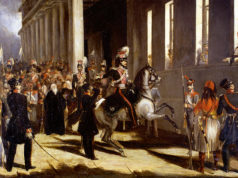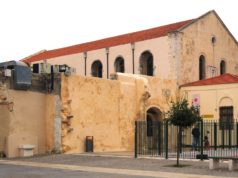 «The street had its own history», just as a popular Greek song of the 60’s mentions. History is alive beside us everywhere. In search of it, we go back in time and it reveals itself right there, in front of us.
«The street had its own history», just as a popular Greek song of the 60’s mentions. History is alive beside us everywhere. In search of it, we go back in time and it reveals itself right there, in front of us.
The holy temple named «Lady of the Angels», celebrates the announcement of Jesus’ conception, on March 25th and is possibly the oldest in town, still in use. It is referred to as «Small Holy Mother of God», so that it is distinguished from the «Great Holy Mother of God» (the Cathedral, also located within the Old Town). The Cathedral celebrates the entry of the Holy Mother of God, as a child, into the Temple, on the 21st of November. That is possibly the reason why, in Rethymno, most of the women named Mary –single and married– celebrate their name days on November 21st, instead of August 15th (i.e. Assumption of Mary), when the majority of Maries, in Greece, celebrate. In some parts of Greece, the local tradition states that the single women named Mary celebrate on November 21st and the married ones on August 15th, which is in accordance with the age of the Holy Mother, during the event celebrated on each date.
The neighborhood, where the temple is located, was known as ‘Saint Lazarus’, during the period of the Venetian conquest (1211-1646), because of the Saint’s, nearby small hidden chapel, somewhere within Neofitou Patelarou Street. Related written testimonies refer to burials and Orthodox christenings (babtisms), in the holy Temple of “Lady of the Angels», since 1585. The temple has not changed much since then, except for the belfry and the surface underneath it, which have been renewed, leading to alterations of the original renaissance door frame, in the middle nave. Such changes are also apparent in the temple of Saint Francis, in Rethymno.
 During the domination of the Ottoman empire (1646-1898), the street on which the temple is located, was referred to as “Uzun Yol” or “Uzun Sokak”, which means «Long Narrow (street)», instead of «Nikiforou Foka» (official name). The streets’ name is translated into Greek as: “Makri Steno” and that is how it is referred to today. During the period of the ‘Cretan State’ (1898-1913), the name of the street was “Enoseos” (i.e. “Unity”). The square which is half the way down this street is called ‘Marias Papaioannou’, in honor of a woman from Rethymno who offered a lot to the local society in the 20th century. She is also known as ‘The soldier’s mother’. One could say, there is a resemblance between this street and Aeolou Street in Athens, which begins from Acropolis (Fortezza in Rehtymno) crosses “Plaka” (Old Town of Rethymno) and reaches the New Town, beginning from the center of the City and continuing all the way up to the edge of the urban landscape (Kourmouli Street, south of the municipal Garden in Rethymno).
During the domination of the Ottoman empire (1646-1898), the street on which the temple is located, was referred to as “Uzun Yol” or “Uzun Sokak”, which means «Long Narrow (street)», instead of «Nikiforou Foka» (official name). The streets’ name is translated into Greek as: “Makri Steno” and that is how it is referred to today. During the period of the ‘Cretan State’ (1898-1913), the name of the street was “Enoseos” (i.e. “Unity”). The square which is half the way down this street is called ‘Marias Papaioannou’, in honor of a woman from Rethymno who offered a lot to the local society in the 20th century. She is also known as ‘The soldier’s mother’. One could say, there is a resemblance between this street and Aeolou Street in Athens, which begins from Acropolis (Fortezza in Rehtymno) crosses “Plaka” (Old Town of Rethymno) and reaches the New Town, beginning from the center of the City and continuing all the way up to the edge of the urban landscape (Kourmouli Street, south of the municipal Garden in Rethymno).
Going back to the history of the temple, the following information refers to how the temple has been formed and changed through time:
- The Temple is a 3 nave basilica without a dome. Its surface is about 200m2 and its maximum height is around 6,50m. The bell tower however, is approximately 15m high.
- Just after Rethymno was occupied by the Ottomans (1646), the Temple was turned into a Mosque (Angebut Ahmet Pasha’s) and there was a minaret added on the southern side, as well as a mihrab (an ornamented niche that points toward Mecca and toward Allah, spiritually) on its eastern wall.
- The minaret’s upper part was destroyed by an earthquake and was never restored, and therefore it is known as the Half destroyed Minaret or «Koutsotroulis» (i.e. Lame Cupola). According to the folk local tradition, it was Virgin Mary’s grace that did not allow the minaret’s restoration.
- During the Ottoman Occupation there was a sculptured inscription within the building, in Arabic language, taken from the Quran that said: “Every time Zechariah entered upon her in the prayer room”.
- The elaborated old icon of “Holy Mary of Passion” (15th century, 2nd half), that originally was inside this Temple, was also honoured by Rethymnian Muslims. But after the Christian Temple turned into a Mosque, the icon was transferred, and today it is kept in Rethymno’s Cathedral.
- In the temples’ courtyard there was a fountain for the prayers to wash their feet in before praying, and three other wells SE and SW of the building, that are now covered and also NW, which is now beneath the road, in front of the temple.
- It has been mentioned that before the Cretan Revolution in 1866, the inscription: «Mariam Lady of Angels», was evident on the outer doorframe of the courtyard.
- Giuseppe Gerola, the archaeologist, with his team, photographed the temple with its half destroyed minaret, when he visited Crete, in order to list the Venetian monuments on the island, circa 1900.
- On the night of Easter Monday, April 3rd – 4th 1917, riots erupted in the courtyard of the «Half destroyed Minaret». What had happened, within the temple, according to one historical version, was that during billeting, of military forces that were preparing for the Asia Minor Campaign, one soldier for several continuous nights was dreaming of a lady in black. She was strongly urging him to search in a specific place and find the Virgin Mary’s icon. On the night of April 3rd – 4th, after seeing the same dream again, the soldier mentioned his dream to his superiors, and when they searched in that specific place, that was revealed to him in his sleep, the icon was found. This icon of the “Odigitria” (i.e. Leader) Holy Mother (circa 1850) is kept today on the right stand, as we enter the Holy Temple. According to another historical version, this incident was purposefully directed by Christians, who were trying to retrieve this ex-Orthodox Temple that had been turned in to a Mosque. After over 250 years, eventually, the temple became an Orthodox Church again, but without its minaret that was then totally destroyed.
- In 1920, a 20 year old girl, named Hepatia K. Moatsou, lived in Rethymno. Unfortunately, she had an incurable (in those years) disease. Just before she died, she decided to donate a certain amount of her fortune, to the temple for the construction of the bell tower. This was promoted by her uncle, who stood beside her during her illness, and was a highly appreciated doctor and member of Greek Parliament, named Themistokles D. Moatsos (whose name has been given to one of Rethymnos’ main streets). There is a marble stone even to this day, situated high above the bell tower, where one can see the dedication inscription. The little icon that the young girl held, up until the end her life, lays now on the stand, on the right hand side, as one enters the Holy Temple.
- One of the most important portable icons, is the one in the back and left hand side of the Holy Temple, of Saint Govdelaas the Great Martyr, from Persia. It is a copy of the original icon made by the famous Renaissance painter, Emmanouel Tzane (Zuanne=John) Bounialis. Written on this icon is the miracle story that took place in the Holy Temple, when Tzanes’ brother, named ‘Fragias’, was cured from a very dangerous illness on September 29th, (circa 1640), which is also the celebration day of saint Govdelaas. The original icon is now kept in the Cathedral of Corfu, where the family of the painter had moved, after the Ottoman Conquer. The third brother, Marinos, has written a 12.000-line poem named: «Cretan War». It is a chronicle regarding the long lasting and difficult battle, with the cooperation of Venetians, Cretans and other Europeans against the ottoman domination on Crete (1645 – 1669). The name Tzane (the stress is on the first syllable!) Bounialis, is also the name of a well known street in Rethymnos’ Old Town, that of course has its own history as well…..
Bibliography
- Michalis M. Papadakis, Rethymno’s Lady of Angels chronicle, Rethymno 1984.
- Kostis Hel. Papadakis, Sculptures and scrips in Rethymno (Environmental Education Programme of Rethymno 1st Gymnasium), Rethymno 2000.
- Charis K. Stratidakis, 370 monumental gaps in historical topography of Rethymno, Rethymno 2014.
- Kostis Hel. Papadakis, Churches, Monasteries (Orthodox and Romancatholic) and neighborhoods of Rethymno Town, during Venetian Occupation, referred in Notaries’ documents [included in issue 33 (2014) of New Christian Crete].
- Eva Ladia, Maria Papaioannou: Angel of kindness and invaluable social contribution activities, May 2014, online (in Greek).
- Holy Bishopric of Rethymno & Avlopotamos’ webpage www.imra.gr
November 2015
Νikos G. Daskalakis
Civil Engineer – master GiS, N.T.U.A.
(nikolasmail@gmail.com)
Edited in English by Katerina Kosti
Certified preschool and TEFL teacher
(KK232323@hotmail.com)






